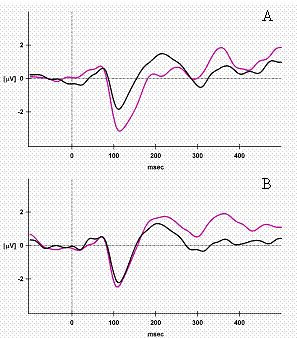151st ASA Meeting, Providence, RI
Multiple Mechanisms of Auditory Attention
Elyse S. Sussman - esussman@aecom.yu.edu
Popular version of paper 4pPP4
Imagine yourself at a lively office party. You hear the sounds of your colleagues in conversations around the room; the clinking of ice in glasses; the music playing in the background. We can easily select certain sounds in the room: to listen to one of the conversations, or to focus on a song that suddenly reminds us of last summer’s vacation. When we focus on part of the sound input at the expense of other concurrent sounds, our experience of the environment has clearly been changed by attentional processes. The goal of my research is to clarify brain mechanisms that facilitate these attentional processes.
To examine effects of attention, we recorded the on-going electrical activity of the brain, called the electroencephalogram (EEG), as measured from electrodes placed on the scalp (see Fig. 1). Portions of the EEG are associated with the stimulus events in a time-specific manner and these time-locked changes in the EEG can be recorded as event-related brain potentials (ERPs). Multiple ERP components are produced by sound stimuli, and each index different stages of auditory processing that can be influenced by attention. In a set of ERP experiments, we show that the brain creates different memories of the same sound input according to the task performed with the sounds. This is important because it shows that the same neurons responding to the features of the sound input interact with attention in different ways at the cortical level to facilitate task performance. Attention is adaptive to the task. That is, attentional influence is specific to what the listener is trying to accomplish within the present sound environment. If we think back to our noisy office party, the idea would be that when you select one conversation in the crowded room, the brain’s response to the other sounds in the room is changed because your goal is to understand the speech sounds from one speaker. After a while perhaps you become bored with your current conversation. You can easily refocus your attention onto another speaker in the room without even turning your head. Refocusing attention to a different speaker will then change the brain’s response to the original speaker even though nothing changed about what your brain is receiving from that original speaker. That person keeps talking with the same intensity level and rate. Attention alters the brain’s response to the sounds based on what we select from all the sounds available and creates different memories according to what is selected. Recent studies have shown that actively focusing on features of the sensory input selectively enhances the neural responses associated with the attended stimuli. This process represents one mechanism by which attention modifies brain function involved in sound perception. In this paper, I show a different effect of attention on sound processing, one that modifies the memory of a series of sounds in a task specific manner, based on the currently perceived auditory sound streams in the environment. It is the series of sounds, not the features of sounds, that generally define auditory objects, such as a melody in music, a barking dog, or a series of footsteps. In one experiment (see Fig. 2), two sounds that differed only in pitch were presented via earphones. Participants were instructed to listen to the sounds and perform different tasks with them. The brain’s response to the two sounds was recorded while they performed the tasks. We show, for the first time, an effect of attention that is related to auditory object perception. When participants performed a task in which the two sounds were perceived as belonging to different auditory objects, the brain’s response to the sounds differed in the first 200 ms (Panel A). In contrast, when they performed a task in which the two sounds belonged to the same auditory object, the ERP response to the two tones was the same (Panel B). The brain’s response to the same sounds was modified based on what was in the focus of attention, demonstrating an interaction between stimulus input and attention that favors task goals.
These results, along with the results of other experiments, show that there is more than one mechanism of auditory attention operating at different processing stages depending on the listener’s task. This is significant because it shows that attention is flexible, adapting neural processes to meet task goals, which helps us perceive relevant auditory objects in the environment. The changes in brain activity may serve to reduce interference from other concurrent sounds in the environment and facilitate the ability to focus on what’s currently important for task performance, whether it’s choosing to listen to one conversation at a party or identifying the melody of the flute within an orchestral suite. References: Sussman, E., Winkler, I., Huotilainen, M., Ritter, W., & Näätänen, R. (2002). Top-down effects on the initially stimulus-driven auditory organization. Cognitive Brain Research, 13, 393-405.
|

